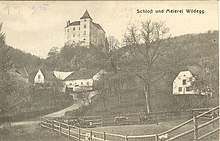Wildegg Castle
| Wildegg Castle | ||
|---|---|---|
| Creation time : | around 1188 | |
| Castle type : | Höhenburg, rocky location | |
| Conservation status: | Received or received substantial parts | |
| Place: | Wienerwald- Sittendorf | |
| Geographical location | 48 ° 5 '8.5 " N , 16 ° 9' 53" E | |
|
|
||
The Burg Wildegg is at Sittendorf , south of Vienna , situated rock castle used as a youth camp. The owner is the Catholic youth group of the Archdiocese of Vienna .
history
Wildegg Castle was probably built between 1136, when the Heiligenkreuz Abbey was founded, and 1188, when it was first mentioned in a document as Wildekk Castle . The first Wildegger, Heinrich, should have built the castle. But where the Wildeggers came from is still unknown today. The building was part of the castle belt on the edge of the Vienna Woods , which served to protect against the Hungarians who frequently invaded from the east. That is why it was built as a rock castle. The part with the tower and the chapel was built later. The original moat was later filled in. The castle was only one story.
But it was only owned by the Wildegger until 1261. The last of the family was Konrad von Wildegg, who was buried in Heiligenkreuz Abbey. Through the inheritance to his daughters, the castle fell to the Altenburg family. In 1346 the Altenburger-Wildeggers probably lost the castle. The forester Leutold Veusel then appears as the owner. Sparbach and parts of Alland also belonged to the lord's possession . Until 1486 the owners changed frequently, like the mercenary leader Hans Holuber , until it was sold to the Neidecker . Under the Neideckern the castle was rebuilt into a Renaissance castle. Wildegg has the first triangular Renaissance courtyard north of the Alps. At the time of the Reformation , the Neidecker changed to the Protestants. As a result, there were repeated power struggles with the Heiligenkreuz Abbey. So the Neidecker were no longer buried in the monastery, but in the nearby church in Sittendorf.
In 1621 the castle was greatly expanded. However , it was heavily damaged again by the increasing number of invading Turks, especially in the course of the Second Turkish Siege in 1683. The Neidecker could not raise the financial means for the necessary repairs. Therefore, the current castle was sold to the monastery on the advice of Emperor Leopold I. The emperor was interested in hunting the castle, but not the means to buy it himself. But the monastery also had to sell other properties nearby in order to have the necessary money.
Abbot Clemens Schäfferm immediately began with the renovations, a new roof and other things. Until 1776 there lived numerous administrators sent by the monastery, which was strengthened again during the Counter-Reformation . Under them the castle got its present size.
In 1923 the castle was leased by a Catholic hiking club and renovated in the following years . In 1945 it was temporarily occupied by units of the Waffen-SS who wanted to build a base, which is why the castle was almost destroyed. Approaching Soviet troops wanted to blow up the castle, but a member of the Wanderfreunde managed to prevent the castle from being destroyed by negotiating with the Soviets. In 1947 the Catholic youth group was founded there. The castle is run by them as a self-catering house.
Web links
- Entry via Wildegg Castle to Burgen-Austria
- Wildegg Castle on the side of the Catholic youth group



